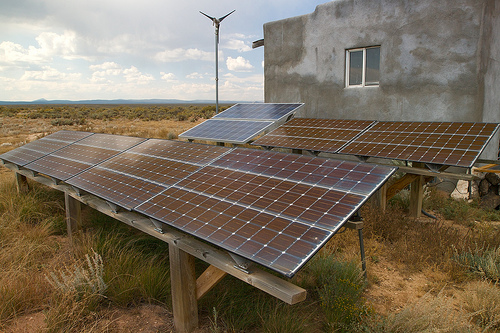 One purpose of my visit to New Mexico last weekend was to see what a self-sustaining single-family habitat in the Southwestern United States would.. or at least could.. look like. Several observations of which those of the region should already be keenly aware…
One purpose of my visit to New Mexico last weekend was to see what a self-sustaining single-family habitat in the Southwestern United States would.. or at least could.. look like. Several observations of which those of the region should already be keenly aware…
- We use entirely too much water. Luxuries such as golf courses in 110 degree (Fahrenheit) heat consume an absurd amount of resources. The Governator officially declared California to be in a drought earlier this year, and Arizona… well… it’s a desert. Maybe we should lay off on the palm trees and grass, hmm? Fighting this hard against the Earth’s ecological tendencies for the sake of luxury is bound to produce the highly inefficient modes of living to which we’ve become accustomed.
- Solar water heaters and photovoltaic collectors will be huge. Output effecientcy levels are increasing, they are approaching blue-colar affordability due to technological improvements and rebate programs, and fall in line with the ideal of consuming local resources.
- We eat poorly, and also consume a tremendous volume of costly non-native food. Foods simply lend themselves better to certain regions and we need to be more explorative of regional food options.
- Gas sucks. We all know it so I won’t go into it 🙁
 This is a snapshot of my own macro-economic sustainability opinions, which change rapidly with the times and fall somewhere between ecological conservatism and hard-nosed financial feasibility.
This is a snapshot of my own macro-economic sustainability opinions, which change rapidly with the times and fall somewhere between ecological conservatism and hard-nosed financial feasibility.
Sustainable American living activists need to focus on three primary goals: (1) significant cultural change in all socioecominic classes, (2) improving sustainability technologies to produce incentives for #1, and (3) figuring out how to reduce the human footprint in economic context to make #1 and #2 plausible. Specific ideas I would like to see pursued..
- Focus aggrocultural subsidies away from small rural farms and onto medium-sized, community-run suburban farming initiatives which share equipment and resources. The notion of the independent, middle-American mom ‘n’ pop farm in Smallville will always be romantic, but you cannot ignore the economies of scale. We need to look at the production possibilities curve of farm size vs. output, factor in waste of transportation costs and pesticidal effects, and find a compromise which will allow significantly-sized local farms to produce native or near-native vegitation within a 20-mile radius of urban areas, while not requiring the populous to return to an aggregarian state or douse everything in chemicals. (Not that chemicals are inherently bad: just unnecessary and wasteful in many cases.)
- Incentivize large-scale adoption of solar water heaters by artificially raising the cost of traditional indoor tank water heaters and using the difference for solar subsidies. It’s ridiculous to spend energy heating a tank full of water in an empty air conditioned home when you could just put a damn tank outside in the sun for 10 minutes and have magnitudes more hot water for free. Sense make that does.
- Incentivize large-scale adoption of household solar arrays by using artificial energy costs to subsidize payments to households selling energy back to the grid via bi-directional meters.
- Plausible sustainability change requires working with the existing system. You can blame The Man all you want, but the world is not going to abruptly adopt better principles overnight. Changes need to come gradually–in a way people can slowly accept and adapt to–in incentives facilitated by the government, demand from the people, and interest of the industry.
- Ceteris paribus, chose local products and services to keep money in the region and reduce waste.
- Recycling costs cities too much. Trashing stuff costs citizens too little. Residents should force the issue with their municipality and compost the sanitary organic waste.
- The food industry needs to stop wrapping every last item in a silly little shrink-wrapped cardboard box and sell everything OEM-hard-drive-style. That is, make one box for the display, but sell the product in an extremely minimalist biodegradable packaging. This will be (1) easier on consumers since there’s less trash to deal with, (2) better for the environment, and (3) cheaper for everyone. You can put as many bright colors and wacky content on the display as you want, as well as print on the biodegradable packaging.
One reply on “Sustainable Living”
Well put. Why subsidize nuclear energy and the petroleum industries when we can invest in solar technologies?
I cannot resist adding my “micro” level views for individuals to consider:
1. Buy less stuff. Period. We are consumers now more than we are even citizens.
2. Use less stuff. Less electricity. Less water. This is really just a part of #1. And it is not hard. It took me about a week to get used to using less water (probably 1/50th as much).
3. Localize. Local foods, local products. Farmer’s markets are a great place to find them, and Phoenix has several. Avoiding Walmart is a big step in this direction. (Not that I do–shopped there tonight, in fact.)
4. No trash. Remember the three R’s: Reduce, Reuse, Recycle. Those are in order of priority. Recycling is the most resource intensive of them. Buying things with less packaging and processing involved is a huge step. Eating healthier makes a big difference, and it is easy–shop around the outside edges of the supermarket. Eat fresh foods, high quality meats, and consider composting.
The keyword from your article (IMO): incentives.